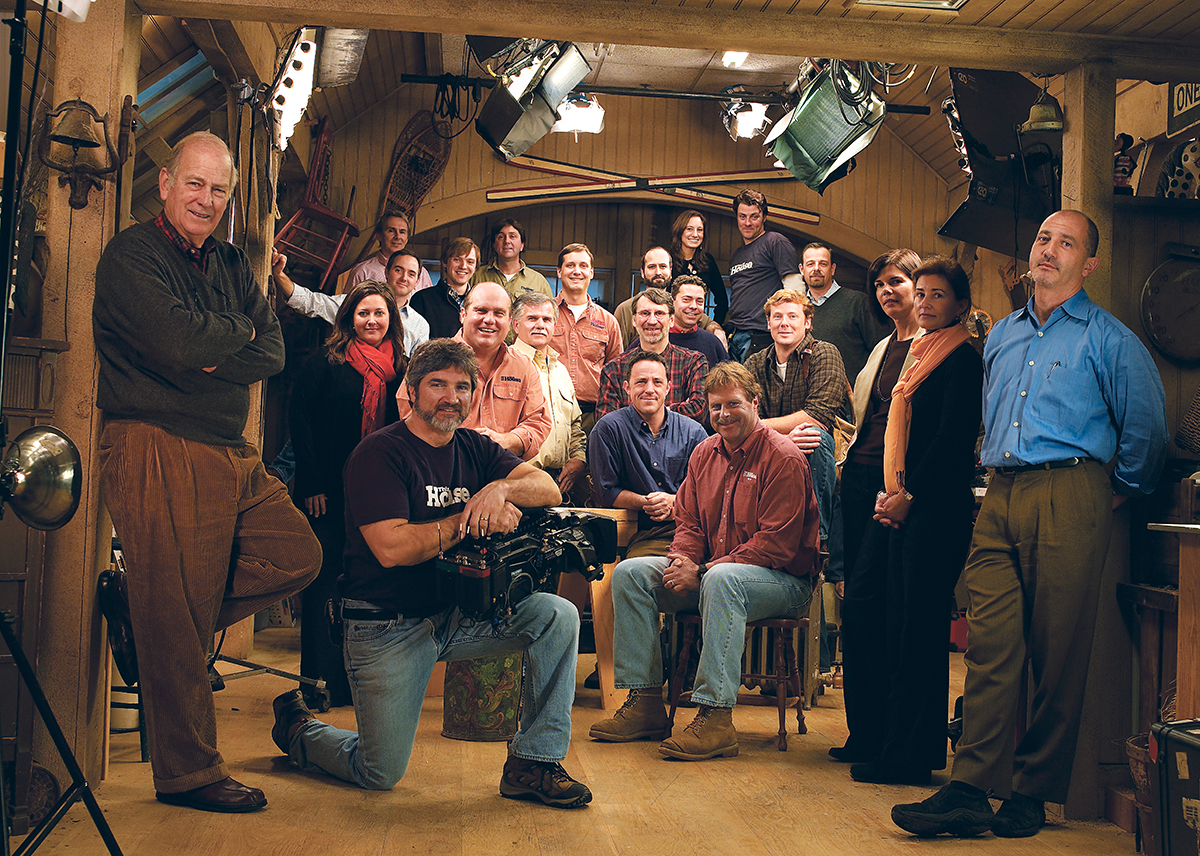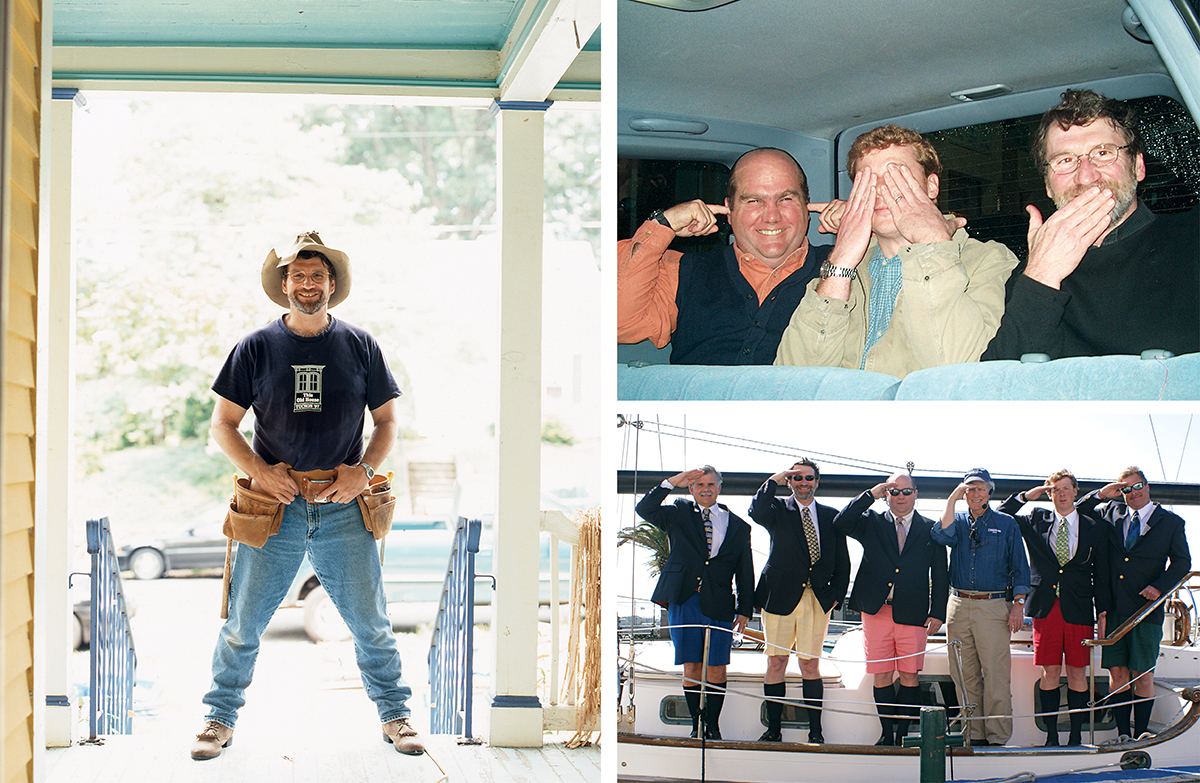This Old House: An Oral History

Current and former cast and crew members reunite at the This Old House studio in Concord. (photograph by walter smith)
Thirty years ago, the cultural landscape for fix-it television was barren. This was before HGTV offered round-the-clock advice on installing ceiling fans; before Extreme Makeover: Home Edition began mass-producing mansions; before viewers were left to puzzle over the subtle difference between A&E’s Flip This House and TLC’s Flip That House.
Then, on the evening of February 20, 1979, WGBH introduced Bostonians to This Old House, a show that would invent a new TV genre. “The words ‘do it yourself’ hadn’t been put together in those days,” says Russell Morash, the program’s creator. “People did not have power tools, did not do their own repairs. They hired people.” Morash, together with WGBH’s Henry Becton, had a knack for distilling latent cultural interests into wildly popular television shows, including The French Chef and The Victory Garden. Premiering just as the country was sliding into a major housing crisis, This Old House (which WGBH spent a mere $50,000 to launch) would show viewers that they didn’t need to buy new homes to be happy. All they needed was a little Yankee ingenuity.
The real estate crunch that had cemented the show’s relevance eventually passed. But viewers’ appetite for DIY tips, not to mention their fascination with other people’s homes, has proved enduring. With nearly 4 million viewers per episode, This Old House has become one of the highest-rated shows of its kind and has won 16 Emmys to date. It spawned a magazine (which now boasts a readership of 5.7 million), a website (that generates 16 million page views a month), and two spinoffs, Ask This Old House and The New Yankee Workshop. Today the various arms of the This Old House brand reach 52 million Americans every month.
As originally conceived, though, the half-hour program that would grow into that multimedia empire promised to be little more than a quaint, televised equivalent of a Realtor’s open house. Initially titled House Calls, each episode would show off a completed home renovation (think MTV Cribs for the PBS set). Morash recruited a Globe journalist named Estelle Bond Guralnick to star in the pilot, which was filmed at a Brookline Victorian she had recently written about. The pilot never aired, though, and the whole experiment might have been shelved had it not been for a certain star quality the producers saw in the Victorian’s young builder, who had escorted Guralnick around his project. His name was Bob Vila.
Henry Becton (former WGBH president): I sat down and reviewed the pilot with Russ. I thought it was okay; I didn’t think it was great.
Russell Morash (series creator): I said, “I think you have to show the process.” It’s too easy to say, “And then I put down this blue tile.” When I see something like what Vila had done with his place, I think, How can I put down my own blue tile? Because I’ll never have the money to do it unless I do it myself.
Becton: Boy, when Vila looked at you through that camera, there was something that really connected. Russ and I thought, Maybe we should try to convince him.
Estelle Bond Guralnick (home design contributor, Boston Globe): Russ just felt awful. He called me and said, “They like Bob Vila.” I was very busy, and life went on.
Bob Vila (former host): They called me up and said, “Come over and take a look at this house in Dorchester. We’ve got everything ready to go.” They had gotten underwriting—I think it was Montgomery Ward—and they had gotten Norm [Abram], who was Morash’s carpenter. This just seemed like a lark.
Morash: Norm had built my barn, and I was so impressed with him I asked if he would be interested in helping out. He was a young unmarried guy, and he said sure.
Norm Abram (master carpenter): I just took the job for some work in a winter of no work. I thought I’d be in the background of a couple of scenes carrying around ladders.
Morash: We had to do extensive work on the gas mains, and I said, “I don’t know anybody who plumbs in the city of Boston.” I mean, I was a suburban guy. I knew as much about Boston as I knew about Marrakesh. The gas company said, “Well, we have this firm over in Roslindale called the Trethewey Brothers.” I said, “The what?”
Richard Trethewey (heating and plumbing specialist): It’s a British name.
Morash: My father came to me and said, “I can’t believe you’re going to put a carpenter or a plumber in front of the camera. What do you expect to learn from these people?” I said, “Dad, I’m not asking them to quote Shakespeare. I want them to tell me, in their own way, how to lay an oak floor, what tools to use, what goes on in their mind.”
Vila: Shortly after the first show aired I went out to supper with my wife and two other couples at the old Ritz hotel. There was some buzz in the room, and one of the guys at our table was ribbing me about people recognizing me. You don’t wrap yourself around the concept of fame very easily early on.
Morash: It cost us about $30,000 to do all the repairs on the first house. When you think about it, you can’t buy half a car for that these days. The house eventually sold and everybody got paid, but ‘GBH never got its $50,000 back. They never asked for it back, because the show had taken off.

Clockwise from left: Master carpenter Norm Abram in a rare flannel-free moment; plumber Richard Trethewey, host Kevin O’Connor, and Abram mug for the camera; in Bermuda during the final season for creator Russell Morash (in slacks), the cast and their captain salute. Photographs by Keller + Keller (Abram); Alexandra Brandon (group, top right); Sacha Blackburn (group, bottom right).
The first season of This Old House, which followed the renovation of the Dorchester home for 13 episodes, was a massive hit that set a new ratings record for WGBH. Its popularity only grew when PBS snatched up the show for national distribution the next season. Viewers found getting advice from real experts—as opposed to actors—uniquely helpful. The format, however, was less popular with contractors.
Trethewey: At first we were nervous that we were giving away trade secrets, like a magician.
Morash: Richard has had to carry an important message back to the plumbing industry: More information on the part of the public is a good thing, not a bad thing. And I think he’s right.
Abram: Contractors would say, “Why are you doing this?” I used to hear that a lot. I felt it was people being insecure. There are going to be do-it-yourselfers no matter what. For those who aren’t going to do it themselves, isn’t it better that they understand your skill and how much work it actually takes? I think contractors finally got that.